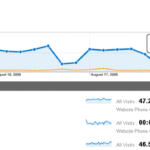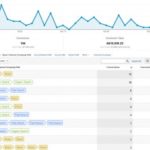A landing page or website’s bounce rate is a metric used to measure how many people visit a website and leave right away versus those that stick around and go through the content. This metric is often represented in the form of a percentage versus the total population of readers that visit a given website.
Reducing a site’s bounce rate often first involves understanding why their are so many visitors coming and going so quickly. Two categories of traffic often make up most of the situations.
The first seems somewhat obvious: the website has the wrong type of content on it, so no one sticks around very long to enjoy the Internet location. They don’t have a reason to explore or review the rest of the material provided. The second possibility seems a bit more like an oxymoron: people are finding exactly what they want and then leaving right away, which is not necessarily a bad thing. This just means the website is then serving its purpose very well. So understanding the nature and context of bounce rate can be just as important as wanting to change it.
If a website owner has pretty much concluded the bounce rate suffers from the first problem, the wrong content, then their are a number of ways to reduce the site’s given bounce rate and improve the "stickiness" of the revised page. These options include:
- Get rid of any popup window features. These tools may seem like an extra way to provide content, but most readers find them completely annoying and use popup blockers to make them useless.
- Enhance your site with more natural webpage navigation. Instead of using pre-determined click link locations, a web page can be designed with far more page navigation tools, allowing a reader to move around a website from more parts of a given web page.
- Speed up your web page. Nothing makes people leave a web page faster than one that won’t load quickly. Readers allow an average of 4 to 5 seconds for a page to load up. If things get stuck, a site loses readers before they even digest any content.
- Enhance a website with dynamic page design. More users are now accessing the Internet through mobile devices. However, a high number of web pages don’t cater to different screen sizes, making mobile users have to zoom to read content. With dynamic page content designs a website will know what kind of device a reader has and will deliver the appropriate screen size and format. People stick around longer because the site then caters to their reading needs.
- Keep the ads to a minimum. Readers go to a website for content, not to read another businesses advertisement. Banner ads and similar are considered disruptive, and too much turns readers off.
- Choose web page colors wisely. White backgrounds tend to be a common default, but many website tend to favor blue. Just don’t choose a color that blinds a reader into irritation.
- Utilize internal search engines specific to a website. This allows people to find the content they remembered from a while back, enhancing return visits. It also allows a site owner to track which pages are bringing people back to then connect further links to it.
- Don’t provide content as a wall of text. Frequently and liberally use titles, subtitles, and breaks in content to allow for easy scanning and reading. Even the most interesting content gets hard on the eyes without any visual breaks in the material.
- Keep web pages focused and clutter-free. This is particularly important for web sites intended to convert interest into sales. Keep the reader focused on why the site exists and the action readers should be taking. Cluttering up a site with unrelated material causes distractions and reduces the conversion turnover desired.
The above tips should not be considered singular in nature. Many good website designers take advantage of multiple tools and methods to reduce their bounce rate and improve the readability of their websites. With combined changes, website owners should see an increase in readers’ visit time as well as longer digestion of content.




